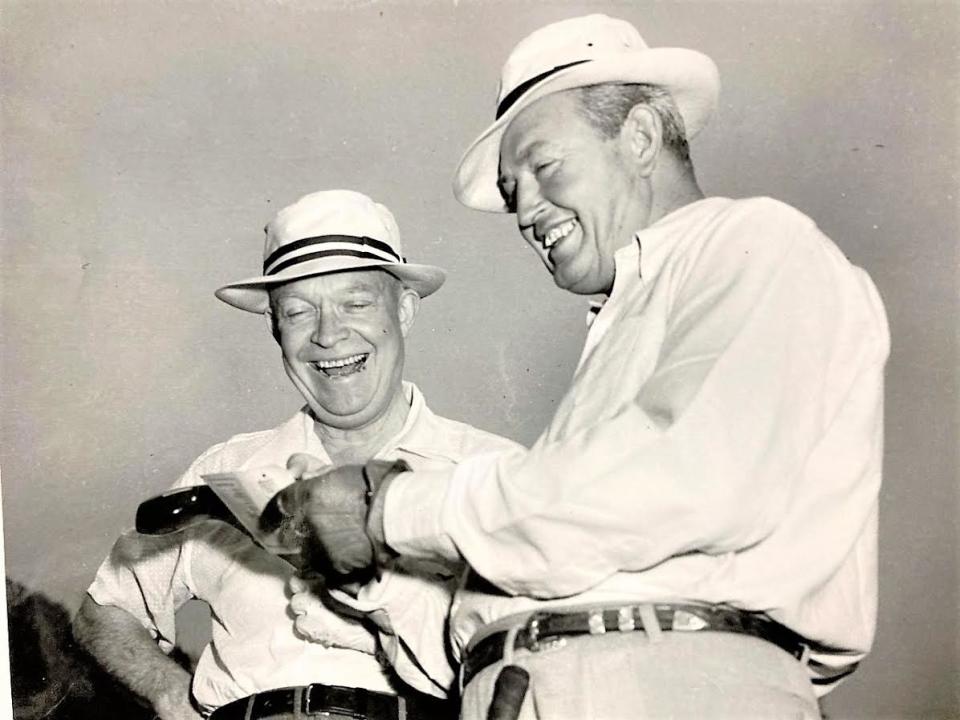Eisenhower Tree's presence at Masters reduced to just a memory 10 years after ice storm
When the 97 players in the field of the 2014 Masters Tournament arrived at Augusta National Golf Club, the veterans already knew a significant part of the tournament’s history was gone.
They’d heard a devastating ice storm in Augusta two months prior to the tournament had dealt a fatal blow to the famed Eisenhower Tree on the 17th hole. Damage was so extensive that the tree had to be taken down soon after the storm.
Estimated by Augusta National to be at least 100 years old, the loblolly pine had been a part of the Masters since its beginning in 1934. The tree was 210 yards from the tee, off the left-center of the fairway. It was estimated to be 65 feet high at the end of its life.
It was known as the Eisenhower Tree, or Ike’s Tree, because President Dwight D. Eisenhower hit it so many times when he was a member from 1948 until his death in 1969.
Vijay Singh, the 2000 Masters champion, said this week, “I don't think anybody talks about it anymore. It was 10 years ago.”
More: Tiger Woods score today at Masters is his worst round in a major. What he shot at Augusta
More: 'Why were we out there': Rahm would have stopped play at Masters on windy Friday
What's the history of the Eisenhower Tree at the Masters?
Maybe it’s not missed as much because so many younger players never had to face it, but it will live on forever because of its back story, which involves Augusta National co-founder and chairman Clifford Roberts.
This is the kind of power Roberts wielded: During a club governors meeting in 1956, Eisenhower proposed cutting down the pesky tree that he kept hitting with his tee shots. According to the Augusta National media guide, Roberts “promptly ruled him out of order and adjourned the meeting.”
At the time, Eisenhower was in the final year of his first term as the President of the United States.
Once word came down that Eisenhower wanted the tree removed, it was forever known as the Eisenhower Tree.
In his 1976 book, The Story of the Augusta National Golf Club, Roberts never addressed the incident with Eisenhower in 1956. He did say Ike was a “congenital slicer” because of a football injury to his left knee. A slice is a right-to-left ball flight, meaning Eisenhower’s shot would often hit the tree before his slice kicked in.
In his book, Roberts said Eisenhower could never be anything but “an average player” mainly because of his left knee injury.
Roberts noted that Eisenhower was a “near expert” in a number of sports but golf wasn’t one of them.
“He had no chance at all to play his favorite game with a comparable degree of skill,” Roberts wrote.
When that 2014 ice storm took down the tree, it also was the end of some smaller trees that had been planted to the left of it.
“Well, I look at the area, it does look a little naked,” Jack Nicklaus said in 2015. “It’s not only Ike’s tree, but Little Ike and a couple other trees were gone. But they really had no effect on the play of the golf tournament. I think the statistics show that I think there’s been an average of maybe five of six balls that have hit the tree a year by bad shots, and it affected the membership far more.”
That’s not the way two-time champion Ben Crenshaw remembers it.

“It was a hazard back then,” Crenshaw said this week. “You had to clout it to get over it or around it in our day with persimmon clubs. I made the joke I hit it so many times it came down.”
Whatever, in the Masters the hole has traditionally played just a little over par – without or without the tree.
In 2014, the last year the tree was up, the scoring average was 4.239 and tied for the sixth-hardest hole.
The first year without the tree, the scoring average was 4.154 and was the seventh-most difficult hole on the course.
Nine years later, through the first two rounds of the 2024 Masters, it is playing as the 11th-most difficult hole on the course with a scoring average of 4.169.
At the time of its removal, there were questions whether the club would replace it with another similar-sized tree.
“It’s hard to replace 80, 90 years of growth like that,” Crenshaw said this week.
“I just think that that tree was so big and old and iconic I don't think they could,” Keegan Bradley said. “I'm sure I hit the tree. I can't remember. I think everybody hit the tree at least a couple times.”
Eisenhower’s tree might be gone, but his name lives on with another Augusta National landmark. In 1949, a three-acre pond was built on the eastern part of the club at the suggestion of Eisenhower.
Known as Ike’s Pond since its creation, it is in the center of the club’s Par 3 Course, where Masters Tournament’s Par 3 Contest, which started in 1960, is held each year.
This article originally appeared on Wilmington StarNews: Eisenhower Tree's legacy slowly fades at Augusta National Golf Club

